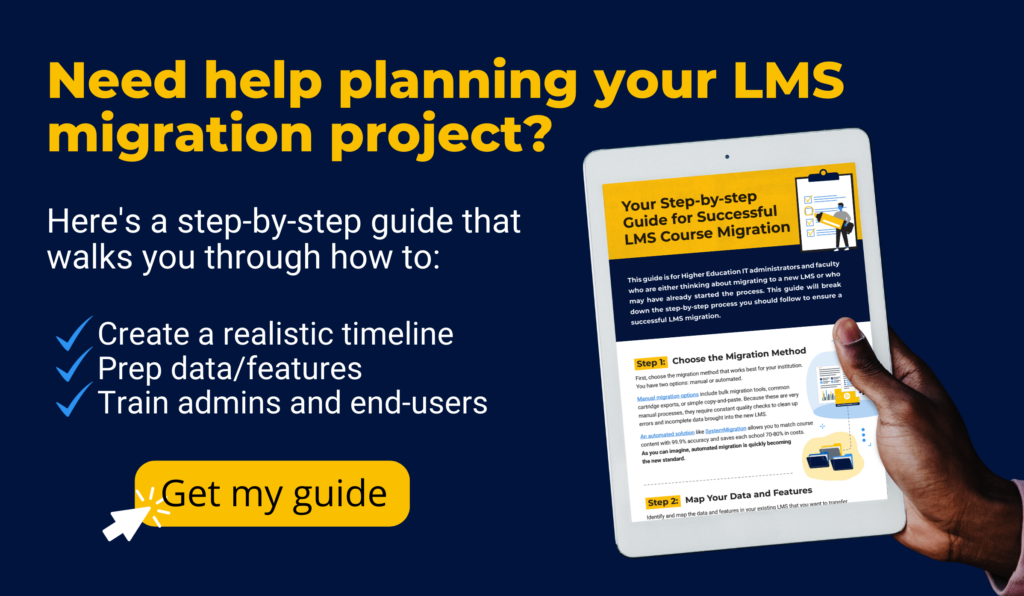5 Steps to Get Faculty Buy-in for New Technology
If you’re reading this blog, it’s because you know that you need faculty support to give your new initiative the best chance of succeeding. At the same time, you also know that getting faculty buy-in for new technology in higher education can be a challenging task.
You’ve come to the right place. This blog will break down 5 steps you can take to build that trust and help faculty know that this new initiative will support them.
3 potential reasons you’re struggling with buy-in
To garner the most support, let’s first look at why faculty may be resistant to new technology through an empathetic lens. Here are 3 potential reasons you might be struggling with faculty trust:
- Varying digital literacy skills,
- Fear of the unknown,
- And lack of communication.
1. Varying digital literacy skills
Varying digital literacy skills is a big reason some may resist change. Some faculty may feel more comfortable sticking to traditional methods because they need more confidence in operating new tools effectively.
2. Fear of the unknown
When encountering a situation or experience that is unfamiliar or unknown, faculty may feel uncertain, anxious, or even fearful. Your goal will be to guide them through the process and help them feel supported along the way.
3. Lack of communication
If you have yet to communicate the reasons for the change clearly, faculty may question the value of this new initiative and wonder if it will make a difference.
Alleviate these fears and build trust through open communication and support by taking these 5 steps.
5 steps to get faculty buy-in for new technology
It’s possible to garner support for new technology following these actionable steps:
- Listen and involve faculty early on.
- Communicate clearly.
- Use data to highlight benefits.
- Share a transparent timeline.
- Provide consistent technical support.
Step 1: Listen and involve faculty early on

This first step is crucial to build that foundational trust. Your job is to support faculty with the tools they need, and the best way to accomplish that is by listening intently.
Create a safe environment for faculty members to provide feedback. You can accomplish this safe space by sending out surveys to allow anonymous feedback. Of course, you can speak one-on-one with faculty as well, but an anonymous feedback channel could provide more honest answers.
Acknowledging concerns is equally important. Even if you aren’t able to appease certain objections, acknowledging the members who gave that feedback and explaining why you are moving a different direction is part of listening and keeping that communication channel open.
Step 2: Communicate clearly
Clear communication has the power to alleviate most, if not all, fears that faculty may have about new technology. Be specific about what is changing and communicate what goals these changes will accomplish.
Step 3: Use data to highlight benefits
Anecdotal evidence or a hunch that something might work is insufficient to garner support for new technology. The best higher ed leaders make decisions based on data and evidence, not “gut instinct.”
Gather and share data that proves the difference the new tool(s) will make for your institution. Highlight how this new initiative will enhance teaching and improve student outcomes.
Gathering all the data points you need from your LMS to help you determine what other technologies or strategies are needed to support students can be simple and easy. Take a look at how Scaffold DataX can help give you a fuller picture of your student by pulling any data point you need out of your LMS.
Step 4: Share a transparent timeline

Faculty can have a hard time picturing the timeline. They often fear that the transition will make teaching more difficult or even impossible.
To alleviate these fears, discuss the following important dates for your transition timeline:
- When you will first introduce the new tool(s),
- When or if pilot-testing will be run with select faculty before rolling it out campus-wide,
- When faculty/staff will have scheduled training,
- Specific dates for each stage of the transition,
- And when the transition should be fully complete.
Step 5: Provide training and technical support
Faculty members will have more trust in you if they know you’re along for the ride with them. Let them know that if issues arise, they can contact someone for support. One way to provide technical support, especially if your IT staff is small but mighty, is to have daily or weekly instructional meetings that faculty can opt in or out of if they need help.
Final thoughts
Building relationships and communication is key to get faculty buy-in for new technology in higher education. By addressing their concerns, sharing a transparent timeline, providing technical support, and demonstrating the benefits through data, you can increase faculty willingness to adopt new tools in teaching practices.
If you need help planning an LMS migration project or extracting/analyzing data from your LMS to make intelligent strategic decisions concerning your EdTech, speak with an expert at K16 Solutions.



